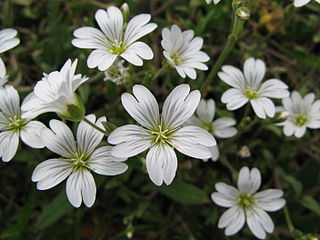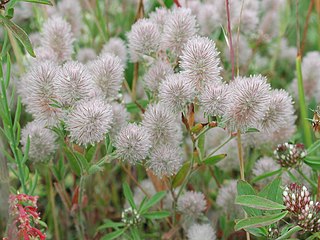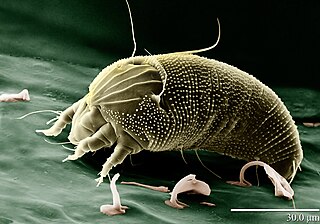
Equisetum is the only living genus in Equisetaceae, a family of vascular plants that reproduce by spores rather than seeds.

Cirsium is a genus of perennial and biennial flowering plants in the Asteraceae, one of several genera known commonly as thistles. They are more precisely known as plume thistles. These differ from other thistle genera in having feathered hairs to their achenes. The other genera have a pappus of simple unbranched hairs.

Cirsium arvense is a perennial species of flowering plant in the family Asteraceae, native throughout Europe and western Asia, northern Africa and widely introduced elsewhere. The standard English name in its native area is creeping thistle. It is also commonly known as Canada thistle and field thistle.

Cerastium is a genus of annual, winter annual, or perennial plants belonging to the family Caryophyllaceae. They are commonly called mouse-ear chickweed. Species are found nearly worldwide but the greatest concentration is in the northern temperate regions. There are about 200 species. A number are common weeds in fields and on disturbed ground.

Trifolium arvense, commonly known as hare's-foot clover, rabbitfoot clover, stone clover or oldfield clover, is a flowering plant in the bean family Fabaceae. This species of clover is native to most of Europe, excluding the Arctic zone, and western Asia, in plain or mid-mountain habitats up to 1,600 metres (5,200 ft) altitude. It grows in dry sandy soils, both acidic and alkaline, soil with dry-mesic conditions and is typically found at the edge of fields, in wastelands, at the side of roads, on sand dunes, and opportunistically in vineyards and orchards when they are not irrigated.

Lithospermum arvense, the field gromwell, corn gromwell, or bastard alkanet, is a flowering plant of the family Boraginaceae. It is also known as Buglossoides arvensis.

Thlaspi arvense, known by the common name field pennycress, is a flowering plant in the cabbage family Brassicaceae.

A noxious weed, harmful weed or injurious weed is a weed that has been designated by an agricultural or other governing authority as a plant that is injurious to agricultural or horticultural crops, natural habitats or ecosystems, or humans or livestock. They may also be termed invasive plants. Most noxious weeds have been introduced into an ecosystem by ignorance, mismanagement, or accident. Some noxious weeds are native. Typically they are plants that grow aggressively, multiply quickly without natural controls, and display adverse effects through contact or ingestion. Noxious weeds are a large problem in many parts of the world, greatly affecting areas of agriculture, forest management, nature reserves, parks and other open space.

Anemopaegma arvense is a medicinal plant native to Cerrado vegetation in Brazil.

Equisetum arvense, the field horsetail or common horsetail, is an herbaceous perennial plant in the Equisetopsida, native throughout the arctic and temperate regions of the northern hemisphere. It has separate sterile non-reproductive and fertile spore-bearing stems growing from a perennial underground rhizomatous stem system. The fertile stems are produced in early spring and are non-photosynthetic, while the green sterile stems start to grow after the fertile stems have wilted and persist through the summer until the first autumn frosts. It is sometimes confused with mare's tail, Hippuris vulgaris.

Cerastium arvense is a species of flowering plant in the pink family known by the common names field mouse-ear and field chickweed. It is a widespread species, occurring throughout Europe and North America, as well as parts of South America. It is a variable species. There are several subspecies, but the number and defining characteristics are disputed.

The Blue Oak Ranch Reserve, a unit of the University of California Natural Reserve System, is an ecological reserve and biological field station in Santa Clara County, California. It is located on 3,260 acres (13.2 km2) in the Diablo Range, northwest of Mount Hamilton, at 1,500 ft (460 m) elevation.
Arvense, a Latin adjective meaning in the fields, may refer to:

Aceria anthocoptes, also known as the russet mite, rust mite, thistle mite or the Canada thistle mite, is a species of mite that belongs to the family Eriophyidae. It was first described by Alfred Nalepa in 1892.

The Polycnemoideae are a small subfamily of plants in the family Amaranthaceae, representing a basal evolutionary lineage. The few relictual species are distributed in Eurasia and North Africa, North America, and Australia.

Melampyrum arvense, commonly known as field cow-wheat, is an herbaceous flowering plant of the genus Melampyrum in the family Orobanchaceae. It is striking because of the conspicuous spike of pink or purple terminal bracts which includes the flowers.

Polycnemum is a genus of flowering plants in the family Amaranthaceae/Chenopodiaceae, native to central, eastern and southern Europe, Morocco, Algeria, Turkey, and Central Asia. Basal in its clade, it has been suggested that it be given its own family, Polycnemaceae.
















